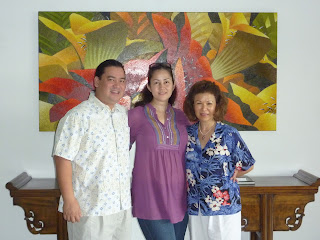Sunday, July 29, 2012
I just had to share this . . .
From The Happiness Project (Author is Gretchen Rubin)
Other people cultivate unhappiness as a way to control others. They cling to unhappiness because without it they'd forego the special consideration that unhappiness secures: the claim to pity and attention...
Some people exploit unhappiness for decades...
The belief that unhappiness is selfless and happiness is selfish is misguided. It's more selfless to act happy. It takes energy, generosity, and discipline to be unfailingly lighthearted, yet everyone takes the happy person for granted. No one is careful of her feelings or tries to keep her spirits high. She seems self-sufficient, she becomes a cushion for others. And because happiness seems unforced, that person usually gets no credit...
My sister, Maite, read this to Tita Mary, when Tita Mary went on her usual discussion about the unhappy state of Tita Patring (i.e., in the eyes of Tita Mary) . . . in contrast to Mom, who exuded happiness in spite of her own challenges in life!
Get a head start on happiness, check out . . . The Eight Irresistible Principles of Fun!
http://www.youtube.com/watch?v=eAmjz8Uzf48
Wednesday, July 25, 2012
Our Friends from Montreal, Canada
 |
| Marianne and Hung Visiting Manila |
This is Marianne and Hung, previously business associates I worked with in Vietnam, they have become good friends. We get excited about similar things, development projects and delicious food from all over the world. When we weren't talking shop, we were contemplating food. I also enjoy listening to their stories growing-up in Vietnam among the elite at the cusp of the communist revolution. Although their respective families lost virtually everything they owned in Vietnam to the communist regime who was particularly zealous in expropriating the assets of the privileged, they were still relatively fortunate as their parents had the means to send them off to study abroad. Then, all hell broke loose in communist Vietnam, forcing them in the prime of their youth to adopt another country as their own, lest they return "home" and suffer the mediocrity of an overwhelmingly plebeian society. In spite of all their tribulations, Marianne and Hung exemplify the virtues of acceptance, perseverance and graciousness. Vive Marianne et Hung!
 |
| Selina, Hung, Marianne and Moi at Bayleaf Hotel, Intramuros |
 |
| Some R&R at Planet Dive Resort, Anilao, Batangas |
 |
| Along the beach at Planet Dive Resort |
 |
| At our home with Marianne |
 |
| At Mom's home (Marianne, Hung, Moi, Paul, Phebe, Maite) |
Monday, July 9, 2012
Our House in Rancho Caridad
 |
| Driveway to the Entrance Gate |
 |
| Formerly the front of the house; currently the right side and rear of house |
 |
| Currently the left side and rear of house |
 |
| Driveway to front of house |
 |
| Front of House The wooden facade is flanked by the entrance staircase and the ground floor and second floor kitchen. |
Today, we visit Rancho Caridad to enjoy the outdoors and the peace and quiet of a rural setting. Here, we are close to Lolo Ego and Lola Ego, whose remains are in the family chapel.
 |
| The resting place of Lolo Ego and Lola Ego |
 |
Historical Note
My grandmother (Caridad Ongsiaco Gallego or Lola Ego) inherited a modest hacienda of about 600 hectares, which was a combination of second growth forest and swamp land. It was raw and it needed work. As was the custom of the era, men--not women--managed farms in those days. So, Lola Ego may have owned it but Lolo Ego developed and took care of it.
In light of the hard-working reputation of the Ilocanos (who were hauled by the American's to Hawaii to plant pineapple in the 1900's), Lolo Ego (through his brother-in-law, Isidoro Del Prado, who was hired as the encargado or manager of the hacienda) enticed Ilocanos from the Ilocos region (along the typhoon belt and having stony unfertile soil) to plant rice on the farm, which had far superior climatic and soil conditions. According to Dad, Isidoro would bring trucks to the Ilocos region to haul and settle batches upon batches of Ilocanos in Nampicuan. This transpired over a period of 3 to 4 years.
In the late 1940's, Lolo Ego purchased the only high school in town (L. C. Gonzales Memorial High School), which was owned by then incumbent Mayor of Nampicuan, Dr. Jose Baguisi, and, harnessing his extensive experience in the education sector (having been a Secretary of Public Instruction), reinvigorated the same under the banner of Gallego Institute of Agriculture and Industry or GIAI, which served the community of Nampicuan for over 60 years (from the late 1940's to 2011) until Dad donated the school to the Roman Catholic Diocese of San Jose, Nueva Ecija. The school is now known as St. Pius X Institute of Nampicuan.
Not long after Lolo Ego's pioneering development work at the farm began to bear fruit, institutionalized land-grabbing by government known ostensibly as agrarian reform gained momentum. Henceforth, the rice land owner was doomed. Unlike landowners of export crops (i.e., foreign exchange earners) like coconut, sugar and tobacco, who had larger tracts of land, were generally much wealthier and, not surprisingly, politically too powerful to be touched, the rice land owner produced and sold just that--rice, the most basic commodity and staple crop for local consumption. Rice land was not a source of wealth but a source of livelihood for an agricultural middle-class that was systematically destroyed for refraining to exert their political clout.
Subscribe to:
Posts (Atom)





